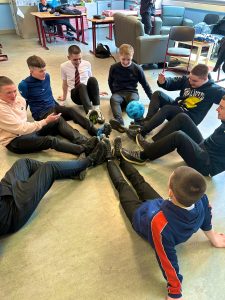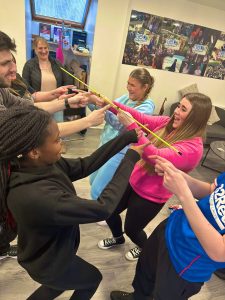With its roots traced back to indigenous populations from all across the globe, restorative justice, or RJ, is one of the most organic and widely used methods of moving forward from acts of harm in a way that is appropriate for both parties involved.
While our partners, Community Justice Scotland, explore what restorative justice could and should look like with the adult population, CYCJ have spent time over the last few months deep diving into what children and young people think of restorative justice, with this work being pulled together to support delivery of the Scottish Government’s Restorative Justice Action Plan. Have children and young people heard of RJ? Do they want RJ? And, if so, how should RJ look and feel for them?
The simple answer, to all of those questions, is yes. The overwhelming sense from young people when exploring RJ, was that this was not a new concept. Of course, it was introduced as being used by indigenous tribes globally for hundreds, if not thousands, of years, but the young people recognised the process, or at least a more organic and informal version of it from a range of day-to-day settings. Young people explained how they had seen restorative justice approaches in school when two pupils had fallen out, had seen it at youth groups as staff tried to manage the relationships of participants and even at home as parents and caregivers tried keep peace between warring siblings.
Young people did, however, recognise the imperfect nature of these informal approaches: the power dynamics at play, the short-term nature and in many cases the lack of consent – so they welcomed a more structured approach to ensuring both a victim of harm, and those who have caused the harm, get what they need from the process – however that might look.
CYCJ’s Participation Team worked with a whole range of children and young people to explore the subject in detail. We worked with pupils from a high school Learning and Development unit as well as pupils enrolled on their Alternative Curriculum programme. We delivered sessions in local youth groups and with school pupils as young as primary five, and, whilst there is alignment with the priorities of the adults involved in similar projects, there were also some key distinctions which should be acknowledged.
Each group had a series of 4-6 sessions which mirrored the sessions delivered by our partners with adults. We explored language, shared understanding and context before dissecting each element of the RJ process to understand what mattered to young people and why.
While the young people unanimously agreed that any restorative justice approach must have the informed consent of both parties, and that sessions should be facilitated in a neutral, yet comfortable, location, there were some points in which the children and young people’s views were quite different from the model that currently exists: with regards to facilitator, children and young people were united in their belief that one facilitator was not sufficient. While one group mentioned it would help young people to feel more comfortable to have a mix of ages and experiences, another came to this conclusion as they deemed that multiple facilitators were more likely to be equipped to break up a fight, should it occur. Our contributors who were aged under 12 thought that multiple facilitators were more likely to make a child feel comfortable as there were more options for them to relationally connect with, while the youth group suggested that the two facilitators should be selected by the participants – with each participant choosing a facilitator from a bank of available workers – empowering young people in a space which will be daunting for both parties. Whatever reason the children and young people had for their choice, all agreed that multiple facilitators would be preferred.
Whilst most of the children and young people stated they would be likely to take part in a restorative justice process if it was offered, some couldn’t decide without being in the situation. They recognised that if they had caused harm, they might have levels of guilt and shame that would make the situation too uncomfortable, but equally they might be too scared if they were a victim to sit down with the person who had caused them harm. While the children and young people couldn’t all make a call on whether they would take part or not, they were clear that for people who did want to take part then safety and comfort should be prioritised.
The children and young people, generally, had a great understanding of all aspects of a restorative justice approach and were able to explore concepts and nuance in detail. The only challenge we faced was for a small number of our participants aged under 12, for whom the concept of ‘justice’ was abstract. The variance in what justice is, what it could be or what it should be, was hard for them to navigate. One of the children in particular not only understood the concept, but articulated their understanding so well they were able to demystify what ‘justice’ was for their peers by referring to the humble chicken nugget. The participant described four different people all having two chicken nuggets and each having one stolen – how would they get justice? They explained that for one person getting the nugget back may be enough, whilst another person might want two chicken nuggets back – one to replace their original nugget and a second as compensation. They also explained, that for person number three, justice wasn’t about having the nugget replaced, but understanding why it was stolen, and why it was stolen from them specifically, while the final person might just want to be assured that won’t happen again. And for all of those individuals, that was justice.
The children and young people supported the idea of restorative justice being made available across Scotland. They recognised the value in repairing relationships and avoiding the overcriminalisation of people in our communities.
It is a child’s right to be included in the decisions that might affect them, so it was a pleasure to facilitate conversations with groups that have been so often overlooked. They routinely ensured they considered a range of diverse perspectives and the needs of others while exploring the topic with compassion, open minds, energy, and curiosity – but most of all, we had fun.
We could all learn a lot from our children and young people.
About the author: Iain Corbett is a Participation Advisor at CYCJ, and former member of our Executive Governance Group. Find out more about Iain here.



Leave a Reply
You must be logged in to post a comment.